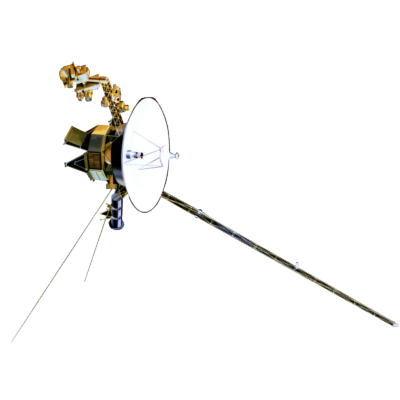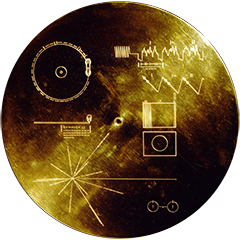Voyager LECP Data Analysis Handbook
Calibrations and Channel Definitions
The Voyager (MJS) LECP Pulse Height Analyzer (PHA)
LEPT Mode
The five pulse inputs (D1 through D5) are shaped pulses from the LEPT section of the experiment. The pulses are generated by charge liberated in the corresponding Low Energy Particle Telescope silicon detectors as radiation penetrates the reversed biased junctions. This discrete charge produces a step voltage at the output of a Charge Sensitive Preamplifier which is further shaped to obtain a bipolar pulse (the pulse duration and shape being a compromise between noise level and count rate capability). The amplitude of this shaped pulse is a function of particle species and energy. When compared with additional detector outputs from a collimated array (the conventional particle telescope) the amplitudes can be used to identify the radiation present. Therefore, an accurate measurement of the voltage peak can be used for analysis of the local particle population.
The bipolar pulse at the end of the amplifier cascade has a zero-crossing of about three microseconds. This signal is further processed by a logarithmic amplifier to obtain a dynamic range of up to 70 db. The PHA peak detectors and A/D converters have a full scale reading of 2.0 volts with a resolution of 2 mV. The last two bits are not accepted by this particular experiment, and thus the experiment resolution is about 8 mV. The PHA dynamic range of 1/256 (for 8 bits only) is expanded to 1/3000 by the previous log amplifier to obtain a constant percentage of reading accuracy. The combined processing allows detection of a 70 db dynamic range to 0.3 db resolution at count rates in excess of 100 pps.
Peak detection is illustrated by Figure 1. This simplified functional schematic and timing diagram shows required control and timing. The Peak Detector tracks the input signal and maintains the highest previous positive level until a negative going zero crossing occurs. The Zero Cross Discriminator triggers a 2 microsecond interval which opens the "Hold" switch.
The pulse that produced the peak and zero crossing is monitored elsewhere in the experiment logic. The two microsecond delay one-shot maintains the output of the peak detector long enough for the data system to decide whether a measurement should be accomplished on the pulse. If the particle appears to be of interest, the "external hold" line goes positive before completion of the two microsecond delay and maintains S1 open until the end of a measurement interval (about 1 millisecond). Note that S1 must be available since there is significant probability a large signal will occur during the 1 millisecond and the peak detecting diode would again conduct.
Once the data measurement is made, or at the end of the two microsecond delay in the absence of a measurement request, the six microsecond one-shot fires closing S2 and discharging the peak storage capacitor. The "hold" signal shown is generated within the PHA electronics, a "GO" pulse from the Command and Data section of the experiment sets the "hold" high and it remains there until a full conversion cycle has been completed.
Timing is arranged in the control circuits so that "hold" switch" overlaps the reset signal and the amplifier does not drive the shorted output. The actual circuit allows any of the five D input lines to initiate the delay and reset cycle, each line having its own threshold discriminator. Thereby, if any line detects a pulse of interest, the levels measured at the other four peak detectors will be for the same instant in time (all "hold" switches open simultaneously).
Circuitry is described in detail later herein. The "hold" switch used for illustration has no physical identity, and the amplifier is gated for continuous negative output voltage and isolation accomplished by the output diode. The "reset" switch is a JFET. Circuit values are critical in obtaining a fast enough slew rate to track the input waveform and retain sufficiently low leakage currents to maintain the stored peak voltage for at least one millisecond with less than a 2% droop.
Peak detector deployment is shown in Figure 2, "Block Diagram Pulse Height Analyzer." One is provided at each D input; no redundancy is used. Their outputs drive multiplexers to each of two redundant analog to digital converters. This is power and circuitry efficient--if one peak detector fails only one channel is lost. Any failure in the remaining electronics would kill the system if it were not redundant. Also, the peak detectors are a major power consuming element of the PHA. Peak detectors may be commanded OFF as desired (i.e., LEMPA mode).
The timing described is faster than the basic operation of the A/D converter electronics which use the 50.4 kHz clock. Therefore, no attempt is made for precise timing between the event and data output. Timing signals are internally generated to be compatible with the data section.
The function described could not be implemented with commercial components available at the time of design. In house hybrid circuits were developed to achieve the power, accuracy, radiation hardening, and speed trade-offs needed.
Return to Calibrations main page.
Return to Voyager
LECP Data Analysis Handbook Table of Contents.
Return to Fundamental
Technologies Home Page.
Updated 8/9/19, Cameron Crane
VOYAGER 1 ELAPSED TIME
*Since official launch
September 5, 1977, 12:56:00:00 UTC
VOYAGER 2 ELAPSED TIME
*Since official launch
August 20, 1977, 14:29:00:00 UTC
QUICK FACTS
Mission Duration: 40+ years have elapsed for both Voyager 1 and Voyager 2 (both are ongoing).
Destination: Their original destinations were Saturn and Jupiter. Their current destination is interstellar space.



